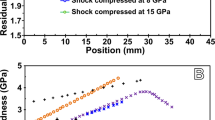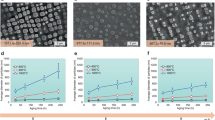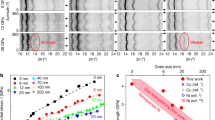Abstract
Nanocrystalline metals, with a mean grain size of less than 100 nanometres, have greater room-temperature strength than their coarse-grained equivalents, in part owing to a large reduction in grain size1. However, this high strength generally comes with substantial losses in other mechanical properties, such as creep resistance, which limits their practical utility; for example, creep rates in nanocrystalline copper are about four orders of magnitude higher than those in typical coarse-grained copper2,3. The degradation of creep resistance in nanocrystalline materials is in part due to an increase in the volume fraction of grain boundaries, which lack long-range crystalline order and lead to processes such as diffusional creep, sliding and rotation3. Here we show that nanocrystalline copper–tantalum alloys possess an unprecedented combination of properties: high strength combined with extremely high-temperature creep resistance, while maintaining mechanical and thermal stability. Precursory work on this family of immiscible alloys has previously highlighted their thermo-mechanical stability and strength4,5, which has motivated their study under more extreme conditions, such as creep. We find a steady-state creep rate of less than 10−6 per second—six to eight orders of magnitude lower than most nanocrystalline metals—at various temperatures between 0.5 and 0.64 times the melting temperature of the matrix (1,356 kelvin) under an applied stress ranging from 0.85 per cent to 1.2 per cent of the shear modulus. The unusual combination of properties in our nanocrystalline alloy is achieved via a processing route that creates distinct nanoclusters of atoms that pin grain boundaries within the alloy. This pinning improves the kinetic stability of the grains by increasing the energy barrier for grain-boundary sliding and rotation and by inhibiting grain coarsening, under extremely long-term creep conditions. Our processing approach should enable the development of microstructurally stable structural alloys with high strength and creep resistance for various high-temperature applications, including in the aerospace, naval, civilian infrastructure and energy sectors.
This is a preview of subscription content, access via your institution
Access options
Subscribe to this journal
Receive 51 print issues and online access
$199.00 per year
only $3.90 per issue
Buy this article
- Purchase on Springer Link
- Instant access to full article PDF
Prices may be subject to local taxes which are calculated during checkout




Similar content being viewed by others
References
Gleiter, H. Nanostructured materials: basic concepts and microstructure. Acta Mater . 48, 1–29 (2000)
Mohamed, F. A. & Li, Y. Creep and superplasticity in nanocrystalline materials: current understanding and future prospects. Mater. Sci. Eng. A 298, 1–15 (2001)
Chokshi, A. H. Unusual stress and grain size dependence for creep in nanocrystalline materials. Scr. Mater. 61, 96–99 (2009)
Darling, K. A. et al. Microstructure and mechanical properties of bulk nanostructured Cu–Ta alloys consolidated by equal channel angular extrusion. Acta Mater . 76, 168–185 (2014)
Darling, K. A., Huskins, E. L., Schuster, B. E., Wei, Q. & Kecskes, L. J. Mechanical properties of a high strength Cu–Ta composite at elevated temperature. Mater. Sci. Eng. A 638, 322–328 (2015)
Giamei, A. F. Development of single crystal superalloys: a brief history. Adv. Mater. Process . 171, 26–30 (2013)
Reed, R. C. The Superalloys: Fundamentals and Applications (Cambridge Univ. Press, 2008)
Meyers, M. A., Mishra, A. & Benson, D. J. Mechanical properties of nanocrystalline materials. Prog. Mater. Sci. 51, 427–556 (2006)
Choi, I.-C. et al. Nanoscale room temperature creep of nanocrystalline nickel pillars at low stresses. Int. J. Plast. 41, 53–64 (2013)
Hornbuckle, B. C. et al. Effect of Ta solute concentration on the microstructural evolution in immiscible Cu-Ta Alloys. JOM 67, 2802–2809 (2015)
Bhatia, M., Rajagopalan, M., Darling, K. A., Tschopp, M. A. & Solanki, K. N. The role of Ta on twinnability in nanocrystalline Cu-Ta alloys. Mater. Res. Lett. http://dx.doi.org/10.1080/21663831.2016.1201160 (2016)
Huang, Y., Menovsky, A. & De Boer, F. Calorimetric analysis of the grain growth in nanocrystalline copper samples. Nanostruct. Mater. 2, 587–595 (1993)
Pollock, T. M. & Tin, S. Nickel-based superalloys for advanced turbine engines: chemistry, microstructure and properties. J. Propuls. Power 22, 361–374 (2006)
Coble, R. A model for boundary diffusion controlled creep in polycrystalline materials. J. Appl. Phys. 34, 1679–1682 (1963)
Ashby, M. F. A first report on deformation-mechanism maps. Acta Metall . 20, 887–897 (1972)
Hirata, A. et al. Atomic structure of nanoclusters in oxide-dispersion-strengthened steels. Nat. Mater. 10, 922–926 (2011)
Liu, G. et al. Nanostructured high-strength molybdenum alloys with unprecedented tensile ductility. Nat. Mater. 12, 344–350 (2013)
Manohar, P., Ferry, M. & Chandra, T. Five decades of the Zener equation. ISIJ Int. 38, 913–924 (1998)
Plimpton, S. Fast parallel algorithms for short-range molecular dynamics. J. Comput. Phys. 117, 1–19 (1995)
Purja Pun, G. P., Darling, K. A., Kecskes, L. J. & Mishin, Y. Angular-dependent interatomic potential for the Cu–Ta system and its application to structural stability of nano-crystalline alloys. Acta Mater . 100, 377–391 (2015)
Segal, V. M. Materials processing by simple shear. Mater. Sci. Eng. A 197, 157–164 (1995)
Furukawa, M., Horita, Z., Nemoto, M. & Langdon, T. G. Review: processing of metals by equal-channel angular pressing. J. Mater. Sci. 36, 2835–2843 (2001)
Zhu, Y. T. & Lowe, T. C. Observations and issues on mechanisms of grain refinement during ECAP process. Mater. Sci. Eng. A 291, 46–53 (2000)
Vincent, R. & Midgley, P. A. Double conical beam-rocking system for measurement of integrated electron diffraction intensities. Ultramicroscopy 53, 271–282 (1994)
Eshelby, J. D. The determination of the elastic field of an ellipsoidal inclusion, and related problems. Proc. R. Soc. Lond. A 241, 376–396 (1957)
Nabarro, F. R. N. Dislocations in a simple cubic lattice. Proc. Phys. Soc. 59, 256–272 (1947)
Herring, C. Diffusional viscosity of a polycrystalline solid. J. Appl. Phys. 21, 437–445 (1950)
Lagneborg, R. & Bergman, B. The stress/creep rate behaviour of precipitation-hardened alloys. Met. Sci . 10, 20–28 (1976)
Du, Q., Faber, V. & Gunzburger, M. Centroidal Voronoi tessellations: applications and algorithms. SIAM Rev. 41, 637–676 (1999)
Bhatia, M. A., Mathaudhu, S. N. & Solanki, K. N. Atomic-scale investigation of creep behavior in nanocrystalline Mg and Mg–Y alloys. Acta Mater . 99, 382–391 (2015)
Yamakov, V., Wolf, D., Phillpot, S. & Gleiter, H. Grain-boundary diffusion creep in nanocrystalline palladium by molecular-dynamics simulation. Acta Mater . 50, 61–73 (2002)
Chokshi, A. H., Rosen, A., Karch, J. & Gleiter, H. On the validity of the Hall-Petch relationship in nanocrystalline materials. Scr. Metall. 23, 1679–1683 (1989)
Schiøtz, J., Di Tolla, F. D. & Jacobsen, K. W. Softening of nanocrystalline metals at very small grain sizes. Nature 391, 561–563 (1998)
Koch, C. C. Structural nanocrystalline materials: an overview. J. Mater. Sci. 42, 1403–1414 (2007)
Chookajorn, T., Murdoch, H. A. & Schuh, C. A. Design of stable nanocrystalline alloys. Science 337, 951–954 (2012)
Murdoch, H. A. & Schuh, C. A. Estimation of grain boundary segregation enthalpy and its role in stable nanocrystalline alloy design. J. Mater. Res. 28, 2154–2163 (2013)
Acknowledgements
M.R., and K.N.S. acknowledge the use of facilities within the LeRoy Eyring Center for Solid State Science at Arizona State University. This work was supported by US Army Research Laboratory under contract W911NF-15-2-0038. K.A.D. acknowledges A. J. Roberts and T. Luckenbaugh for synthesis of the Cu–Ta powder.
Author information
Authors and Affiliations
Contributions
K.A.D., K.N.S. and R.S.M. equally contributed to the idea. K.A.D. and B.C.H. processed the nanocrystalline materials. M.K. performed the creep experiments. M.R. characterized the microstructure data and analysed deformation-mechanisms maps. M.A.B. performed the modelling work. K.N.S., K.A.D., M.R. and R.S.M. analysed the data. K.N.S., K.A.D., M.R. and R.S.M. wrote the paper. K.A.D. and M.R. edited the figures. K.A.D. supervised B.C.H., R.S.M. supervised M.K., and K.N.S. supervised M.R. and M.A.B.
Corresponding author
Additional information
Reviewer Information Nature thanks J. Cormier, S. Forest and T. Perez Prado for their contribution to the peer review of this work.
Extended data figures and tables
Extended Data Figure 1 X-ray diffraction analysis.
X-ray diffraction plot showing Cu and Ta reflections from the as-received NC Cu–10 at% Ta sample processed at 700 °C.
Extended Data Figure 2 As-received microstructure characterization. TEM characterization of as-received NC Cu–10 at% Ta.
a, Precession diffraction TEM micrograph revealing orientation detail of nanometre-sized grains. b, Phase map of the region in the TEM micrograph in a showing two distinct phases: Cu (red) and Ta (green). c, Bright-field TEM micrograph showing the microstructure. d, Size distributions of Cu and Ta grains determined from 300 grains.
Extended Data Figure 3 TEM characterization of a Ta-rich nanocluster.
a, HR-TEM micrograph of a Ta-rich nanocluster with misfit lattice dislocations. b, Inverse fast Fourier transform image of the nanocluster in a highlighting the misfit dislocations (indicated by the yellow boxes) across the interface indicative of the presence of misfit strain.
Extended Data Figure 4 Mechanical behaviour of NC Cu–10 at% Ta at quasi-static strain rates.
Stress–strain response of NC Cu–10 at% Ta samples. a, Compressive stress–strain curve tested at a strain rate of 8 × 10−4 s−1 at various temperatures5. b, Tension–compression curve for samples tested at a strain rate of 1 × 10−3 s−1. The blue line and red diamonds corresponds to tensile and compressive data, respectively. The curves indicate behaviour ranging from elastic to nearly plastic with no strain hardening; tension–compression asymmetry is absent.
Extended Data Figure 5 Creep response of NC Cu–10 at% Ta with and without threshold correction.
a, Creep rate versus applied stress without threshold correction for various temperatures. b, Creep rate versus applied stress with a stress exponent of five for various temperatures, used to extract the threshold stress. c, Creep rate versus normalized stress, obtained by subtracting the threshold stress (σth) from the applied stress (σ) for various temperatures. The red, green and blue circles in a–c correspond to NC Cu–10 at% Ta tested at 400 °C, 500 °C and 600 °C, respectively. d, Theoretical deformation map with threshold-corrected data (n = 5) of the NC Cu–10 at% Ta alloy, along with experimental creep rates of NC Cu and Ni (ref. 2). Theoretical Coble creep rates for a grain size d = 50 nm (circles), experimental creep rates2 in nanocrystalline copper (squares; d = 25 nm) and nickel (diamonds; d = 40 nm), and the creep rate we found for NC Cu–10 at% Ta (triangles; d = 50 nm) are plotted.
Extended Data Figure 6 Atomistic models used for creep study.
a, Initial microstructure of pure NC Cu. b, Microstructure of pure NC Cu after 5 ns. c, Initial microstructure of NC Cu–10 at% Ta. d, Microstructure of NC Cu–10 at% Ta after 5 ns. In all panels, green atoms are grain-interior (face-centred cubic) atoms, red atoms are stacking faults (hexagonal close-packed) atoms, white atoms are grain-boundary (other) atoms and blue atoms are Ta (body-centred cubic) particles.
Extended Data Figure 7 Isolated single grain illustrating the effect of Ta nanoclusters on grain-boundary motion.
a, b, 2D atomistic slices of a single grain obtained from pure NC Cu (a) and NC Cu–10 at% Ta (b) highlighting the effect of nanoclusters in coarsening. White atoms represent the initial grain-boundary configurations and blue atoms represent Ta; red and green atoms represent the extent of coarsening associated with the plastic deformation under constant load and temperature conditions.
Supplementary information
Creep simulation of NC-Cu and NC-Cu-10at.%Ta
(a-b) provides 2-D movies of 3-D atomistic creep simulations of NC- Cu and NC-Cu-10at.%Ta from t=0 to t=5ns. White atoms correspond to the GB configuration in NC Cu, while green atoms correspond to that of NC-Cu-10at.%Ta where the Ta atoms are color coded in blue. There is evidence of microstructural instability in (a) whereas in (b) the degree of coarsening is limited. (MP4 10441 kb)
Rights and permissions
About this article
Cite this article
Darling, K., Rajagopalan, M., Komarasamy, M. et al. Extreme creep resistance in a microstructurally stable nanocrystalline alloy. Nature 537, 378–381 (2016). https://doi.org/10.1038/nature19313
Received:
Accepted:
Published:
Issue Date:
DOI: https://doi.org/10.1038/nature19313
This article is cited by
-
Enhanced Microstructural Stability and Hardness of Multi-component Nanocrystalline Nickel Alloys Processed via Mechanical Alloying
Metallurgical and Materials Transactions A (2024)
-
Thermal Stability and Mechanical Properties of Cu-Nb Nanocomposite Thin Films
Journal of Materials Engineering and Performance (2023)
-
In situ atomic-scale observation of dislocation climb and grain boundary evolution in nanostructured metal
Nature Communications (2022)
-
Manufacture-friendly nanostructured metals stabilized by dual-phase honeycomb shell
Nature Communications (2022)
-
Deformation-Assisted Rejuvenation of Irradiation-Induced Phase Instabilities in Cu-Ta Heterophase Nanocomposite
JOM (2022)
Comments
By submitting a comment you agree to abide by our Terms and Community Guidelines. If you find something abusive or that does not comply with our terms or guidelines please flag it as inappropriate.



